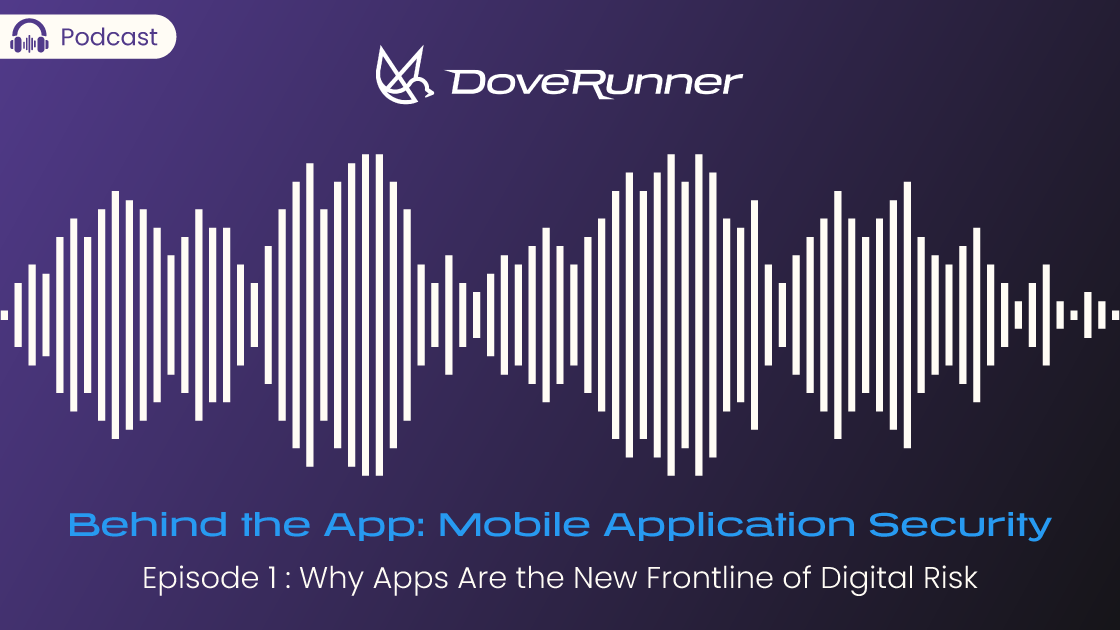Summary
In this episode of Behind the App, host Tanusha Raj chats with Zaid Imam, Product Manager at DoveRunner, about why mobile apps have become prime targets for cyberattacks.
As users share more data across countless apps and connected devices, vulnerabilities grow. Zaid highlights how businesses can combat this with real-time, mobile-first security (RASP) — protecting apps from threats like malware and emulators without affecting user experience.
The takeaway: Strong mobile security can be seamless — and it’s essential to protect your users, data, and trust.
Transcript
Tanusha Raj: Hello security nerds! So welcome to Dove Runner’s podcast series Behind the App, where we explore what’s really happening behind the screens of the applications we use every day. From protecting content to security code, we bring you insights from the front lines of cybersecurity and product innovation.
I’m your host, and today’s episode dives into something that touches almost every part of our lives mobile applications. So think about it. From banking to healthcare, from social media to shopping. Everything is happening on mobile, right? And yet, mobile apps are fast becoming a hot spot for security breaches. But why is that? What’s changing in the mobile ecosystem and most importantly, what can be done about it? So to break this down, I am joined by the Product Manager at DoveRunner who’s working closely on solving some of these real world mobile security challenges. So welcome to Behind the App.
Zaid Imam: Thanks, Tanusha. Thanks for having me here. And let’s get this rolling.
Tanusha Raj: So the first question for you is why do people feel today that mobile applications are becoming the source of security breaches? Why do you think that?
Zaid Imam: Very interesting question to start with. So I’ll give you a perspective to think about it from ground zero. For example, let’s take an example of yours or mine, in our mobile phone, if you see we have one hundred plus application in our phone, and if you categorize them broadly, all of that one hundred, you are using maybe ten applications for your payment purposes, five applications for your day to day travel from point A to point B, you might be using your mobile application for your daily purchasing, for example, retail or e-commerce. E-commerce application. Right. And if you see that you are providing good enough information to every application, from making a transaction to providing your location to providing your space where you are in. So with that, if you see if an attacker is able to grasp any of this information, they have good enough evidence to crack you. And if you see, uh, the more we are connected towards mobile phones, we are more connected towards openness and over the internet because your mobile phone is connected with your watches, which you are wearing, your devices, for example, Alexa and so on and so forth. Similar devices. Right. So you’re opening yourself more and more into the internet ecosystem and then the more you are open, you’re more prone to get attacked by bad attackers, etc.. So it’s a very, very interesting piece to see from outside. But the inside is a little scary to see how this whole market is driving at this point in time.
Tanusha Raj: It’s wild to think about how much we trust. Actually, uh, we put in our phones every day without realizing how vulnerable these apps can be behind the scenes. Right? So can we get, uh, deep about that?
Zaid Imam: This whole mobile, uh, space. So if you see. Right, like, when this whole, uh, attack surfaces started growing. right? And with a lot of applications coming into the market. Uh, we have seen that there is a good enough demand, uh, good enough information about it available in the mobile application surface side, where you are creating a lot of applications day in, day out. Uh, on an average, I think if you see, uh, people publish thousands of applications on Play Store, App Store, and there are more play stores coming to the market, for example, who I am building their own store, right. Which means if a company is building two applications today, they will move to creating three applications or four applications. Right. And once you build that as a business, you get a responsibility to protect your application in multiple ways. For example, you yourself want to protect, right? Second is you get regulatory documentation from governing bodies that you have to ensure you are protecting your customer data. Right. So that’s the second point to look into. Third is because you have a system available as a developer cycle, you want to ensure your developer cycle is also being safe and secure. So to do all this, I think business owners are thinking how we shall ensure our application is being protected. And with that they start from a place, for example, ensuring they are very much secure when the payment is being done, which means there’s no malware being utilized during your payment process. They are ensuring they want to ensure, for example, mITM type of attacks being done, and at that point in time, an attacker is not able to intercept the traffic and if they are able to intercept the traffic, they are able to know your customer, right? So to ensure all this problem is not happening, uh, business owners want to enable such a solution, right? And that’s where we come into the picture where we enable a mobile application security, which is a real time application self-protection security piece.
Tanusha Raj: That really sounds like a game changer, especially for industries dealing with sensitive content or financial data. Right? So what do you think? How should businesses look at these problems and how complex is it to solve them?
Zaid Imam: See, if you think from a business perspective, every business owner wants to solve their own use case, right? Uh, as I mentioned, a payment industry would be more interested in solving problems like social engineering or phishing or mITM attacks. And there is no fraudulent transaction being happening, right? But on the other hand, let’s say a company who is into retail and e-commerce, they want to ensure that they are having a real order being placed, not the fake orders. Right. And also, they are delivering to the real person, not to the fake person. Right. So they have a different use case. If you take an example of hospitality or hospitals as a hospital, right. In that way they want to ensure their patient data is safe and secure where the hospitality wants. Their guest data is secure, right? So everyone is having a very different perspective to solve and to serve those categories right. We think from a mobile first approach because we were born in that era, right where we are thinking from mobile first problem solving approach where we try to start from protecting their whole application itself. We don’t touch upon like a very broader or generalist category, where we go into the niche and try to solve your problem from mobile first approach, for example, understanding the environment, like from which environment you are coming from, whether you are coming from an environment which is rooted, or environment which is having a VM or emulators or a fake device. Right. So we start from there and then we get into tools. We get into categories like advanced protection or macro bot detection. Right. So we enlarged our capacity there. And with that we are able to provide and serve the across use cases without impacting your customer interactions or experience. This is how we see at this stage.
Tanusha Raj: That’s really refreshing to hear. It’s often assumed that more security means more friction. But what uh, but what you’re saying, it can be seamless if planned, right? Right. So it has been such a rich conversation around, and we talked about why mobile applications are now seen as breach prone. Right. Unpacked the mobile apps space and tackled how businesses can actually start addressing the problem today. So thank you so much for joining us today.
Zaid Imam: I think you really summed up very well, like how we should ensure that friction is not there when we are enabling security. So it’s a very wonderful line you have added at the end. So thank you so much for having me, Tanusha. All your pleasure to be on. And yeah, let’s call that a win. Yeah.
Tanusha Raj: So to everyone tuning in, if you’re building or scaling mobile applications now, now’s the time to look under the hood and protect what matters most: your users, your data and your trust. So if you would like to explore how Dev Runners Mobile RSP solution can help you secure your mobile applications, please visit Dove Runner com or connect with our team. Thank you so much! This is behind the app. I’m Tanusha and until next time, stay curious and stay secure. Thank you so much.
FAQs
1. What is DoveRunner’s “Behind the App” podcast about?
DoveRunner’s Behind the App podcast explores the unseen world of app security — from protecting digital content to securing mobile code. Each episode features industry experts discussing real-world cybersecurity and product innovation insights.
2. Why are mobile applications becoming a major source of security breaches?
Mobile apps handle sensitive user data like payments, location, and personal details. As users install more connected apps and devices, the attack surface widens — making it easier for hackers to exploit weak security points.
3. What are the common mobile security threats discussed in the podcast?
The podcast highlights threats such as man-in-the-middle (MITM) attacks, social engineering, malware, fake transactions, and phishing — all of which can compromise sensitive data and user trust.
4. How can businesses protect their mobile applications from such threats?
Businesses can adopt Real-Time Application Self-Protection (RASP) solutions to safeguard apps from within. DoveRunner’s Mobile RASP helps detect rooted devices, emulator environments, and suspicious activities without affecting user experience.
5. Why is a “mobile-first” approach important for app security?
Since most modern transactions and user interactions happen via mobile, a mobile-first security strategy ensures threats are addressed at the core level — from app development to deployment — for maximum protection.
6. Does stronger mobile security mean a poorer user experience?
Not necessarily. As discussed in the podcast, effective security can be seamless and frictionless when integrated strategically, allowing users to stay secure without facing performance or usability issues.
7. Which industries can benefit most from mobile application security solutions?
Sectors such as banking, healthcare, e-commerce, hospitality, and telecom can greatly benefit. Each has unique security challenges — from protecting patient data to preventing payment fraud — that require tailored app protection.
8. What makes DoveRunner’s mobile security solutions unique?
DoveRunner focuses on real-time, in-app protection using intelligent threat detection. Its Mobile RASP solution secures apps without altering the user journey — offering robust protection against dynamic and emerging cyber threats.
9. Where can I learn more about DoveRunner’s mobile security solutions?
You can explore DoveRunner’s Mobile RASP solutions and case studies by visiting doverunner.com or contacting their team for a demo.




